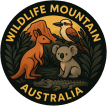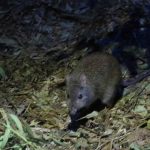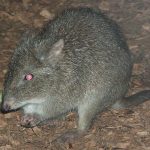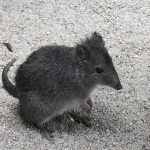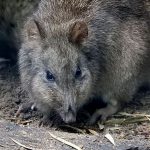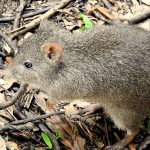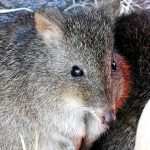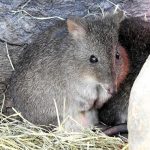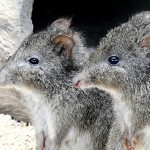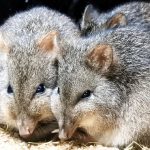LONG-NOSED POTOROO
The Long-nosed Potoroo
A twilight wanderer of the understorey
As dusk settles over a damp coastal heath, a small shape stirs at the edge of the tea-tree scrub. Soft as a moth’s wing, leaf litter shifts and releases the earthy scent of wet soil and fungi. A Long-nosed Potoroo lifts its pointed snout, whiskers trembling, ears rotating like tiny satellite dishes. With a quick, purposeful hop it pauses, then digs—neat, conical scrapes that pockmark the forest floor. A few sniffs, a careful nibble, and it finds what it is searching for: a truffle hidden beneath the soil. The forest is quiet, but underground, relationships are humming. With every bite, this shy marsupial is feeding a much larger story—the health of the entire woodland.
Quick facts
| Feature | Detail |
|---|---|
| Scientific name | Potorous tridactylus (family Potoroidae) |
| Size | Head–body 30–40 cm; tail 20–26 cm |
| Weight | Typically 0.7–1.3 kg (often larger in Tasmania) |
| Lifespan | Up to 6–7 years in the wild |
| Activity | Mostly nocturnal and crepuscular |
| Diet | Primarily underground fungi (“truffles”), plus roots, tubers, seeds, insects and other invertebrates |
| Breeding | Usually one joey; can breed year-round, with a little over five weeks’ gestation; pouch life about four months |
| Range | South-eastern mainland Australia and Tasmania |
| Habitat | Dense ground-layer vegetation in heathy coastal scrub, wet and dry eucalypt forest, and rainforest edges |
| Role in ecosystem | Disperses spores of mycorrhizal fungi that support tree health and soil function |
What they look and feel like in the field
- A compact, soft-furred marsupial with a distinctly long, tapered nose and bright, dark eyes.
- Fur is grey-brown above with a paler belly; the tail is lightly furred and used for balance.
- Hind feet are built for quick, springy movement; they often move in short, low hops, ducking quickly through cover.
- Their diggings are small, neat, conical holes—like a scoop taken from the earth—often 3–5 cm across, scattered where fungi are abundant.
If you’ve seen bandicoots, think of a potoroo as their longer-nosed, more hopping cousin. Bandicoots tend to scuttle; potoroos hop and disappear smoothly into dense understory.
Life and habits
- Shelter and pathways: By day, potoroos rest in shallow nests lined with leaves under thick shrubs or fallen logs. Over time they create well-used runways through the undergrowth.
- Home range: Females often keep smaller home ranges (a few hectares), while males roam more widely in search of food and mates.
- Social life: Largely solitary, they meet mostly to breed.
- Breeding rhythm: Typically one joey at a time. Mothers can mate soon after birth, with the new embryo pausing development until the pouch young is independent—a smart strategy in variable environments.
A story beneath the soil: Potoroos and truffles
The Long-nosed potoroo is a specialist forager of hypogeous fungi—our native “truffles.” Using a keen sense of smell, it detects truffles buried in leaf litter and soil. After eating them, the potoroo spreads microscopic spores across the forest floor.
- These fungi form partnerships (mycorrhizas) with the roots of eucalypts, banksias and many shrubs.
- The partnership helps plants draw up water and nutrients, improving drought tolerance and growth.
- In turn, the fungi receive sugars from the plants. Potoroo diggings also aerate soil and help rainfall soak in.
In simple terms: potoroos farm the forest’s underground allies, keeping soils alive and trees resilient.
Where they live
- Mainland: Patchy populations from far south-east Queensland through eastern New South Wales and eastern Victoria, favouring places with thick, continuous ground cover and soft soils.
- Tasmania: More widespread, including some Bass Strait islands.
- Habitat specifics: They thrive where the understorey is dense—heath, bracken, tea-tree, sedges—and where fire history and moisture allow fungi to flourish.
Conservation status and challenges
Status varies by place:
- Tasmania: More secure overall, though some local declines occur.
- Mainland: Many populations are fragmented and declining. The species is listed as Vulnerable in New South Wales, and threatened or of concern in parts of Victoria and Queensland. The Tasmanian subspecies is listed as Vulnerable under national legislation.
Key threats:
- Predation by foxes and feral cats.
- Loss and fragmentation of dense understorey through clearing or intensive logging.
- Inappropriate fire regimes that simplify the ground layer or burn too frequently.
- Competition and habitat trampling by deer and other introduced herbivores.
- Roads, domestic dogs, and climate-driven shifts in moisture that affect fungi.
How to help
- Keep dogs on lead in bushland and at night near wildlife-rich areas.
- Support fox and cat control programs and responsible pet ownership.
- Favour cool, patchy burns and long-unburnt refuges in fire management to maintain dense understorey.
- Retain fallen logs, leaf litter and native groundcover in forest management and on private land.
- Slow down when driving at dawn and dusk in forested areas.
- Contribute sightings (and photos of distinctive diggings) to citizen science platforms used by local conservation agencies.
Gentle fieldcraft: seeing one without stress
- Use a red-filtered light when spotlighting and keep beams low and brief.
- Watch quietly from a distance; avoid approaching or feeding.
- Look for signs at first light: fresh, conical diggings, truffle rinds in the soil, and narrow tunnels through heath.
Did you know?
- The species name tridactylus
means “three-toed,” referring to the structure of the hind foot in this branch of marsupials. - In good seasons, a female can raise two joeys in a year, thanks to embryonic diapause.
- Where potoroos disappear, some forests lose a major spore-disperser, and the subtle decline in soil health can ripple outward to plants, insects and birds.
The Long-nosed potoroo is easy to miss and hard to forget. It is a quiet engineer of the bush, working at night to keep the living threads between soil, fungi and forest intact. Protecting its habitat and reducing predators does more than save a small marsupial—it helps entire ecosystems breathe a little easier.
